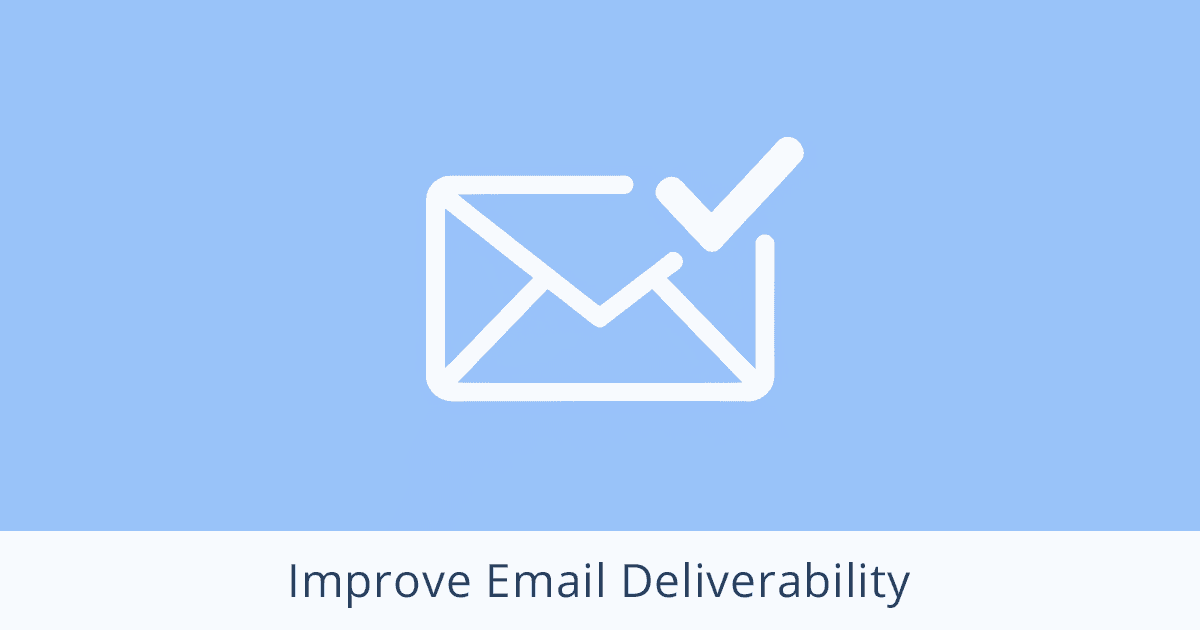
Email Deliverability Checklist to Improve Your Domain's Reputation
February 26, 2025
This is a quick checklist with actionable steps to improve your email deliverability. The outcome is better delivery rates and fewer messages ending in the recipient's junk folder.
Terms
- DMARC: Domain-based Message Authentication, Reporting, and Conformance
- This DNS record gives instructions on handling emails that fail SPF or DKIM checks
- DKIM: Domain Keys Identified Mail
- This DNS record confirms email authenticity
- SPF: Sender Policy Framework
- Defines which mail servers can send emails from your domain
- Quarantine: Recommended policy to set in your DMARC record
- When an email fails SPF or DKIM checks, it's sent to a quarantine folder
- Email spoofing: When an email appears to come from a different sender than the actual sender
Tools + Resources
MX Toolbox: An excellent tool for checking domain and email issues, referenced multiple times in this guide.
Spamhaus: Popular provider of blacklists, tools, andinformation about spam and internet safety.
Google Admin Toolbox: Google's DNS records inspector.
Google Postmaster Tools: Simple dashboard to quickly check email compliance.
Checklist
✅ DMARC: Confirm you have a policy enabled
Having a DMARC policy helps improve email security + deliverability + allows you to monitor inbound emails that got filtered out by your email service provider before landing in your inbox.
Without DMARC, your emails are more likely to end up in junk folders.
Google recommends to always set up DMARC, DKIM, and SPF records for your domain to improve email delivery. See details in their Email sender guidelines.
Quick check: Go to mxtoolbox.com, enter your domain name then click MX Lookup
If you see a failed test for the DMARC, add a DMARC record (or update if yours is incomplete):
- Log into to your domain registrar and edit the DNS settings
- Create a new TXT record (or edit your current record if you have one)
- For the host add _dmarc
- For the value add v=DMARC1; p=quarantine; rua=mailto:dmarc-reports@yourdomain.com
Note: replace dmarc-reports@yourdomain.com with the address you want to receive the DMARC reports, it can be any address at your domain.
By setting the dmarc policy to quarantine (p=quarantine), emails that fail DKIM or SPF checks are automatically sent to a quarantine folder.
You can see these quarantined emails in your email provider's dashboard. For example, if you're using Google Workspace, you'll find that at https://admin.google.com/ac/apps/gmail/quarantine.
It's good to regularly monitor this to allow or deny emails.
For example, most of the emails we get at our primary domain (orderautomator.com) that land in the quarantine folder are from spammers, but occasionally a legit customer email lands there (usually because they don't have all the items in this checklist in order 🤓).
✅ DKIM + SPF: Confirm they're enabled
These records improve email security by defining which IP addresses can send email on your domain's behalf (SPF) and by cryptographically signing your emails to verify authenticity (DKIM).
If you're already sending email from your domain then you probably already have at least one of these enabled, but it's good to confirm + add both if possible.
Use the MX Supertool and select SPF record lookup from the button dropdown to validate your SPF records.
If you have multiple SPF records, combining them into a single SPF record can prevent deliverability issues. This is the policy advised by Google Workspace.
For checking DKIM, you'll have to start in your domain registrar's DNS settings.
- Look for a TXT record that contains _domainkey in the host (or name) field. Copy the value before the period
- In the MX Supertool select DKIM lookup from the button dropdown enter your domain name + colon + the value you copied in step 1. Example: yourdomain.com:mx
- Run the test and confirm the results are all good
If either of these checks yield a problem, investigate the info provided to fix those issues.
If you only have an SPF record, setting up DKIM should further enhance your email authentication and deliverability. If you're unsure, check your email service provider settings and contact them if it's unclear.
✅ Check email blacklists
Email providers use public blacklists to help determine if an email should land in spam. If your domain gets reported as spam too many times, you'll start landing in these blacklists.
Use the MX Supertool and select Blacklist Check from the button dropdown to check your domain against popular email blacklists.
If you are on any of these blacklists, recommended action is to go to that blacklist's site to investigate and see how to solve the problem.
You can also go directly to the blacklist sites (you'll see various after running the MX Toolbox blacklist check) identify problems and learn more.
Spamhaus is a popular authority on IP and domain reputation. You can check your domain's reputation at spamhaus.org/domain-reputation. Your reputation should be positive.
✅ Clean your email list
Having a clean email list means you are sending emails to people who want to receive them, and lowering the chances of bounced emails or spam complaints.
Quick tips:
- Set up a recurring task (monthly / quarterly) to analyze and clean your email list
- Remove bounced subscribers + invalid email addresses
- Don't add people to your marketing list who haven't opted in
- Do not buy email lists or send bulk cold emails
- Remove inactive subscribers
Your email marketing software should have documentation on how to check those tips and clean your list.
For example if you're using ConvertKit, you can follow this guide to clean your list.
Bounced subscribers or invalid email addresses can occur from people typing in the wrong email address when signing up to your list. If these addresses aren't cleaned, they'll continue bouncing, lowering your deliverability stats and possibly adding negative reputation points to your sending domain.
Cleaning your email list also helps save you money on your monthly email software cost, since you're not paying for inactive subscribers.
✅ Follow best practices for email marketing
Quick tips:
- Send relevant emails to relevant people
- Make it easy to unsubscribe to reduce spam complaints
- Avoid overusing potentially spammy words like "urgent offer", "final offer", "free money", etc.
- Don't use large images, or excessive images
- Make sure you don't have broken links in your emails
- Consider separating transactional and marketing emails using different subdomains or sending addresses
- Encourage replies and calls to action to improve engagement
Your email marketing software probably has good documentation on this topic as well.
ConvertKit, for example has a nice detailed guide: 25 email marketing best practices to build a lasting content strategy.
Diving deeper
Missing DMARC record is the most common issue I've seen. If you have that set, confirmed your DKIM / SPF records are good from your email service provider, and operate your marketing with integrity then you should be good to go. 👍
If you want to dive deeper, MX Toolbox has a lot of tools and information.
And for the content / marketing aspect, consult an expert email marketer. They can help give you up to date data backed suggestions for your niche and audience, and help with current best practices. I don't have a good recommendation but if I were looking for one I would first ask around in my network, then forums, then LinkedIn.
🧙♂️ If you liked this post please check out our apps Order Automator and Product Automator.
✅ They have a suite of tools to automate tasks + extend Shopify functionality, and they're FREE to try. Our mission is to help Shopify stores and the people that work in them save time and money.
 Author: Joe
Author: Joe










Any thoughts?